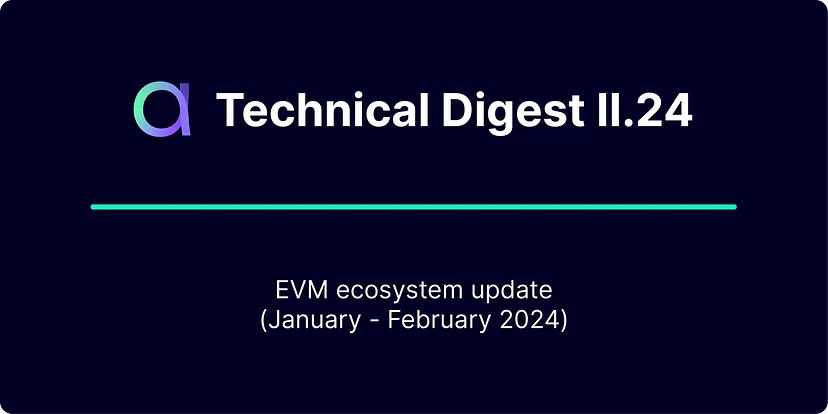In this new monthly series, we provide an overview of ecosystem, tech and research news, initially starting out from the EVM ecosystem. These articles are provided by Ed Prinz, co-founder and President of DLT Austria, and are aimed for the experienced reader. If you require specific background to get you started on EVM technicalities, please check out this source here.
1. Environment News
Leadership Transition and New Initiatives at the Enterprise Ethereum Alliance in 2024
Karen Scarbrough has taken over as the interim Executive Director of the Enterprise Ethereum Alliance (EEA) in 2024, succeeding Daniel C. Burnett, who now serves in an advisory capacity. The EEA thanks Daniel for his contributions and looks forward to his continued advice.
A new Executive Director will be named by the end of Q1 2024. The EEA also plans to hold weekly office hours starting February 2 to engage with both members and non-members about Ethereum’s future. The organisation underscores Ethereum’s crucial role in enterprise as a universal settlement layer, highlighting its potential for tokenising stable tokens and real-world assets.
The EEA aims to bridge various stakeholders in the Ethereum ecosystem to foster sustainability, agility, and a clear understanding of Ethereum’s benefits and infrastructure.
Source: https://twitter.com/thekscar/status/1751999184910049551
The promise and challenges of crypto + AI applications
The article by Vitalik Buterin discusses the intersection of cryptocurrency and AI, exploring potential collaborations and the benefits they could bring to each other’s ecosystems. It examines how cryptographic techniques and decentralised finance (DeFi) principles can enhance AI’s security and fairness, while AI could offer innovative solutions to challenges faced by the crypto world.
The focus is on creating a symbiotic relationship that leverages the strengths of both fields to address their respective weaknesses, aiming for a future where technology operates in a more integrated and mutually beneficial manner.
Source: https://vitalik.eth.limo/general/2024/01/30/cryptoai.html
ArbOS Version 11
The AIP for ArbOS Version 11 introduces several enhancements to the Arbitrum network, including compatibility with the EVM Shanghai upgrade and the new PUSH0 opcode, alongside various bug fixes. These updates, now fully audited, aim to improve the network’s efficiency and user experience across Arbitrum chains.
This version is part of Arbitrum’s continuous efforts to align closely with Ethereum’s developments, ensuring that the network remains secure, up-to-date, and capable of supporting a broad range of applications and services.
Source: https://forum.arbitrum.foundation/t/aip-arbos-version-11/19696
L2 Fee Markets
In the “RollCall 2.2 Breakout — L2 Fee Markets” video from January 31, 2024, the discussion revolves around how fees are determined and managed in Layer 2 (L2) blockchain networks.
The main focus is on the complexities and challenges of setting prices for transactions and the possibility of creating a uniform approach to fees across different L2 solutions. This includes examining how changes in fee structures could affect existing contracts and exploring the idea of a standardised fee mechanism that could make it easier to understand and predict costs.
The conversation highlights the need for improvement in how fees are calculated and suggests that finding common ground among various L2 networks could lead to better efficiency and user experience.
Source: https://www.youtube.com/watch?v=URa8Jn-0aU4&t=2s
Solo stakers: The backbone of Ethereum
The “Ethereum Solo Staker dataset” on GitHub, presented by the Rated Network, is a compilation aimed at providing detailed information relevant to individuals staking Ethereum on their own. This dataset is likely to include various metrics, statistics, or tools that solo stakers can use to optimise their staking strategies, understand the landscape of solo staking, and potentially improve their outcomes in the Ethereum network.
Solo stakers are individuals who operate their own validator nodes to support Ethereum’s security. The post discusses how identifying these solo stakers is complex because of the mix of data sources needed. It emphasises the importance of solo stakers in keeping Ethereum safe and diverse, showing that even though they are a small percentage of all validators, they play a crucial role in the network’s overall health and security.
Source: https://github.com/rated-network/solo-stakers
Decentralized Crypto Governance? Transparency and Concentration in Ethereum Decision-Making
The study provides a detailed analysis of Ethereum’s governance, highlighting its openness and the significant role a small group of individuals play in shaping Core Ethereum Improvement Proposals (EIPs). Despite the broad community engagement, a core group and a few developers dominate the decision-making and software changes.
The research also notes the impact of governance decisions on Ethereum’s price, with Ether’s value notably increasing around the final discussions of Core EIPs. Over time, governance concentration has slightly decreased, yet the Ethereum Foundation remains influential.
Source: https://papers.ssrn.com/sol3/papers.cfm?abstract_id=4691000
2. Development News
EIP-7569: Hardfork Meta — Dencun
The Ethereum network is planning several upgrades. The Dencun mainnet upgrade is scheduled for epoch 269568 on March 13.
EIP-7569, known as the Dencun network upgrade for Ethereum, encompasses improvements across Ethereum’s execution and consensus layers. It includes various EIPs that introduce new functionalities and optimizations, like transient storage opcodes, shard blob transactions, and changes to the Ethereum Virtual Machine (EVM) for enhanced performance and security. The advantages include increased efficiency and capabilities of the Ethereum network. Potential disadvantages, while not explicitly mentioned, could involve the complexity of implementing these changes and the need for the Ethereum community to adapt.
The Holešky testnet was smoothly upgraded to Dencun without any incidents. Sepolia testnet has already smoothly transitioned to Dencun. For the Prague upgrade, discussions are ongoing about potential inclusions like EOF or EIP4444, with decisions expected in two weeks. The Osaka upgrade will prominently feature Verkle trees, though building these trees and executing transactions may slow down by about 10%. These upgrades aim to enhance Ethereum’s functionality and efficiency.
The document describes a proposal for the Ethereum network, focusing on a specific improvement. It outlines technical specifications and aims to address a particular aspect of Ethereum’s functionality or performance. For detailed information about the proposal, including its goals, technical details, and potential impact on the Ethereum network, read the full articles in the source section.
Sources: https://eips.ethereum.org/EIPS/eip-7569, https://twitter.com/ethpandaops/status/1755197602931327379, https://www.youtube.com/watch?v=KE4VH-lSfHg&t=154s, https://twitter.com/parithosh_j/status/1752468658868126030, https://notes.ethereum.org/@Kolby-ML/HJ-9D5aYp
https://cdn.embedly.com/widgets/media.html?src=https%3A%2F%2Fdocs.google.com%2Fpresentation%2Fembed%3Fid%3D1R_UkS0WyGN1FK3qYxSBK5zZxBbN8Cx2mFHQj6rQ0jRA%26size%3Dl&display_name=Google+Docs&url=https%3A%2F%2Fdocs.google.com%2Fpresentation%2Fd%2F1R_UkS0WyGN1FK3qYxSBK5zZxBbN8Cx2mFHQj6rQ0jRA%2Fedit&image=https%3A%2F%2Flh7-us.googleusercontent.com%2Fdocs%2FAHkbwyL9m9WDV2HX13Blfk4gKIMmg8lFyiawluffnEVejyo8xt2SrNhI5MOK42tkyQu2-xbcUe6-CebMEl6aUgURtpq1U4gCWh1Pq4LKy8L38GmrZQ%3Dw1200-h630-p&key=a19fcc184b9711e1b4764040d3dc5c07&type=text%2Fhtml&schema=google
https://cdn.embedly.com/widgets/media.html?src=https%3A%2F%2Fwww.youtube.com%2Fembed%2FRoQ6Gy-KbUs%3Fstart%3D5%26feature%3Doembed%26start%3D5&display_name=YouTube&url=https%3A%2F%2Fwww.youtube.com%2Fwatch%3Fv%3DRoQ6Gy-KbUs&image=https%3A%2F%2Fi.ytimg.com%2Fvi%2FRoQ6Gy-KbUs%2Fhqdefault.jpg&key=a19fcc184b9711e1b4764040d3dc5c07&type=text%2Fhtml&schema=youtube
Osaka upgrade: EIP7607
The Osaka upgrade, also known as meta EIP7607, involves enhancements to the Ethereum network. It includes the reboot of the Kaustinen testnet with new features and fixes, specifically focusing on Verkle trees, a key component for scaling and efficiency improvements. Additionally, discussions and updates from the Verkle implementers’ call are shared through a video and notes, providing insights into the technical aspects and progress of the implementation. These efforts are part of the ongoing development to optimise and secure the Ethereum blockchain.
The document is a proposal for the Osaka network upgrade on the Ethereum blockchain, listing and discussing Ethereum Improvement Proposals (EIPs) considered for inclusion.
It outlines the technical specifications, activation details across different networks, and the rationale behind the upgrade. The upgrade aims to enhance Ethereum’s functionality and efficiency through various proposed changes and improvements.
For more detailed information, the full text of the proposal can be found in the source.
Sources: https://github.com/ethereum/EIPs/pull/8159/files, https://twitter.com/gballet/status/1753390094567047643, https://www.youtube.com/watch?v=YTwUc38GiUI&t=7s, https://twitter.com/rudolf6_/status/1752966751254618547
Enable validators to possess greater effective balances, while keeping the minimum threshold at 32 ETH.
EIP-7251 proposes increasing Ethereum validators’ maximum effective balance to 2048 ETH, allowing in-protocol consolidation where validators can merge their stakes without exiting and re-entering the network. This aims to streamline large staking pools by enabling them to merge validators efficiently, avoiding reward losses during consolidation. The EIP seeks to simplify validator management and enhance solo staking experiences by enabling auto-compounding of rewards and flexible balance staking. This consolidation process is vital for reducing operational complexities and adapting to future Ethereum staking demands.
Source: https://notes.ethereum.org/@fradamt/maxeb-consolidation
Updates to Ethereum’s client software
Recent updates to Ethereum’s client software include performance and stability improvements across both consensus and execution layers.
For the consensus layer, updates include fixes and enhancements for the Deneb upgrade, with specific changes like updated libraries for better network communication and user experience improvements.
- Lodestar v1.15.0: fixes for Deneb upgrade, js-libp2p updated to v1 and minor fixes for UX & performance improvements. https://github.com/ChainSafe/lodestar/releases/tag/v1.15.0
- Nimbus v24.2.0: stability improvements for Deneb.
https://github.com/status-im/nimbus-eth2/releases/tag/v24.2.0 - Prysm v4.2.1: older CPUs without AVX support will have failures on testnets.
https://github.com/prysmaticlabs/prysm/releases/tag/v4.2.1
On the execution layer, a notable fix addresses an issue with viewing recently retired blocks. These updates are crucial for maintaining the network’s reliability and efficiency, ensuring compatibility with various hardware and enhancing overall user experience.
- Version 2.57.2 of Erigon addresses an issue with RpcDaemon that caused it to incorrectly display blocks that have been phased out recently.
https://github.com/ledgerwatch/erigon/releases/tag/v2.57.2
The proposed Ethereum Improvement Proposals (EIPs) and Ethereum Request for Comments (ERCs) aim to enhance various aspects of the Ethereum network and its applications.
EIPs address changes to network protocols, including validator penalties, the Osaka hardfork, gas pricing adjustments, and handling of contract creations with non-empty storage.
- EIP7605 proposes uniform penalties for validators, while Meta EIP7607 introduces the Osaka hardfork.
- EIP7609 aims to lower the gas costs for TLOAD/TSTORE operations.
- EIP7610 suggests reverting contract creation if the storage isn’t empty, ensuring cleaner contract deployment.
ERCs propose standards for token approvals, risk monitoring in transactions, and the management of NFTs across different blockchains, focusing on interoperability and security. These proposals reflect ongoing efforts to optimize Ethereum’s efficiency, security, and user experience.
- ERC7604 introduces permit approvals for ERC1155 tokens, enabling more efficient token management.
- ERC7606 focuses on monitoring transaction risks to enhance security.
- ERC7611 discusses governance for NFTs that operate across different blockchains, ensuring their sovereignty and interoperability.
Sources: https://github.com/ethereum/EIPs/pull/8149/files, https://github.com/ethereum/EIPs/pull/8159/files, https://github.com/ethereum/EIPs/pull/8158/files, https://github.com/ethereum/EIPs/pull/8161/files, https://github.com/ethereum/ERCs/pull/223/files, https://github.com/ethereum/ERCs/pull/229/files, https://github.com/ethereum/ERCs/pull/231/files
3. Research News
Genuine DeFi as Critical Infrastructure
The paper “Genuine DeFi as Critical Infrastructure: A Conceptual Framework for Combating Illicit Finance Activity in Decentralized Finance” explains how DeFi (Decentralised Finance) is challenging because it operates without traditional middlemen, making it hard to apply laws against illegal money activities. A new paper proposes a way to solve this, suggesting how to keep DeFi safe while staying true to its technology.
First, it talks about defining systems that rely on central figures, which could help in applying anti-money laundering rules. Then, it suggests recognising genuine DeFi systems as critical infrastructure, meaning they’re very important and should be protected by a part of the government. Lastly, it introduces a new category for businesses that deal with DeFi but don’t control it, suggesting they have certain responsibilities to help protect against threats but not treating them as traditional financial institutions under the law.
This approach aims to balance the need for safety and the growth of DeFi by considering both government and industry perspectives.
Source: https://papers.ssrn.com/sol3/papers.cfm?abstract_id=4607332
Properties of issuance level: consensus incentives and variability across potential reward curves
The article discusses the impact of different reward strategies on the security and behavior of blockchain networks, focusing on how these rewards can influence consensus mechanisms — essentially, how decisions are made and agreed upon in the network. It examines various models for distributing rewards for participating in the network, such as creating new blocks or validating transactions, and how these models affect the overall stability and security of the blockchain.
The discussion includes an analysis of the variability in rewards and how it might influence the actions of participants, aiming to find a balance that encourages participation while maintaining the network’s security and integrity. This exploration is crucial for understanding how to design blockchain systems that are both secure and efficient, ensuring that participants are motivated to act in the best interest of the network.
Properties of issuance level
The document explores how changing the level of rewards issued in the Ethereum network affects the balance and incentives for those staking their cryptocurrency. It discusses the idea of adjusting the total rewards given out to maintain the network’s security and participation without overpaying.
The analysis includes examining different scenarios to understand the impacts on both the network’s economics and the behavior of individual stakeholders. Through various models and discussions, it aims to identify strategies that could optimise the equilibrium between staking supply and demand, ensuring the network remains secure and efficient.
Source: https://notes.ethereum.org/@anderselowsson/HyUIqjo_6
https://medium.com/smape-capital/evm-ecosystem-monthly-report-january-2024-12a4c1ae4ae5

